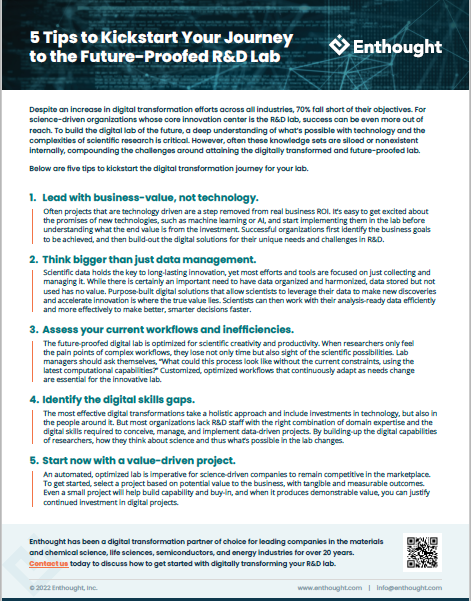5 Tips to Kickstart Your Journey to the Future-Proofed R&D Lab
Despite an increase in digital transformation efforts across all industries, 70% fall short of their objectives. For science-driven organizations whose core innovation center is the R&D lab, success can be even more out of reach.
To build the digital lab of the future, a deep understanding of what’s possible with technology and the complexities of scientific research is critical. However, often these knowledge sets are siloed or nonexistent internally, compounding the challenges around attaining the digitally transformed and future-proofed lab. Below are five tips to kickstart the digital transformation journey for your lab.
1. Lead with business-value, not technology.
Often projects that are technology driven are a step removed from real business ROI. It’s easy to get excited about the promises of new technologies, such as machine learning or AI, and start implementing them in the lab before understanding what the end value is from the investment. Successful organizations first identify the business goals to be achieved, and then build-out the digital solutions for their unique needs and challenges in R&D.
2. Think bigger than just data management.
Scientific data holds the key to long-lasting innovation, yet most efforts and tools are focused on just collecting and managing it. While there is certainly an important need to have data organized and harmonized, data stored but not used has no value. Purpose-built digital solutions that allow scientists to leverage their data to make new discoveries and accelerate innovation is where the true value lies. Scientists can then work with their analysis-ready data efficiently and more effectively to make better, smarter decisions faster.
3. Assess your current workflows and inefficiencies.
The future-proofed digital lab is optimized for scientific creativity and productivity. When researchers only feel the pain points of complex workflows, they lose not only time but also sight of the scientific possibilities. Lab managers should ask themselves, “What could this process look like without the current constraints, using the latest computational capabilities?” Customized, optimized workflows that continuously adapt as needs change are essential for the innovative lab.
4. Identify the digital skills gaps.
The most effective digital transformations take a holistic approach and include investments in technology, but also in the people around it. But most organizations lack R&D staff with the right combination of domain expertise and the digital skills required to conceive, manage, and implement data-driven projects. By building-up the digital capabilities of researchers, how they think about science and thus what’s possible in the lab changes.
5. Start now with a value-driven project.
An automated, optimized lab is imperative for science-driven companies to remain competitive in the marketplace. To get started, select a project based on potential value to the business, with tangible and measurable outcomes. Even a small project will help build capability and buy-in, and when it produces demonstrable value, you can justify continued investment in digital projects.
Share this resource! Click here to download the PDF of “5 Tips to Kickstart Your Journey to the Future-Proofed R&D Lab”
More resources on building the science lab of the future here.
Questions? Fill out the form below to connect to one of our experts today and change what’s possible in your R&D lab with machine learning and AI-assisted custom solutions.
Related Content
BRIEFING: Next Generation Materials Informatics
View Webinar-on-Demand Live webinar held on October 9, 2024 JST The original event was presented to a Japanese audience. While parts are in Japanese,…
[Resource] Materials Informatics: Artificial Intelligence for Curation of Information and Knowledge Acquisition
As competition in new material development intensifies, the importance of knowledge acquisition to accelerate R&D is increasing. Download this book chapter authored by Enthought experts:...
What Materials Informatics Looks Like in the Modern R&D Lab
The Modern Materials Science and Chemistry Lab Industry success now more than ever is being dictated by the ability to continuously develop innovative new materials…
Cheat Sheet | Large Language Models+ For Scientific Research
Large Language Models+ For Scientific Research Updated August 2023 LLMs and Tools for R&D To help scientists and researchers navigate the increasing number of advanced…
WEBINAR: What Every R&D Leader Needs to Know About ChatGPT and LLMs
View Webinar-on-Demand Live webinar held on June 27, 2023 Overview ChatGPT and the explosion of advanced Large Language Models (LLMs) are disrupting every industry. We…
WEBINAR: Drug Development in the AI-Driven Lab
October 24, 2023 Overview The recent advancements in artificial intelligence (AI) and large language models have unleashed a new era of possibilities for drug development….
WEBINAR: Materials Informatics for Product Development: Deliver Big with Small Data
May 17, 2023 Overview For many industry labs, scientific data has historically been generated to answer specific, immediate research questions and then archived to protect…
Unlocking the Value of High Throughput Screening Pipelines in Small Molecule Drug Discovery
Transforming High Throughput Screening Data into Actionable Insights with Data Modeling and Visualization A mid-size small molecule cancer therapeutics biotechnology company using a custom high…
Why Top Materials Company Idemitsu Partnered with Enthought to Accelerate Product Innovation using Materials Informatics
Idemitsu’s Path to R&D Digital Transformation Idemitsu has a rich 100 year history of developing products alongside leading OEMs from project onset, and today is…
[eBook] Digital Transformation in the Life Sciences Industry
The Lab of the Future: Barriers to Digital Transformation in the Life Sciences Industry Experts predict over the next two years, life sciences companies will…
